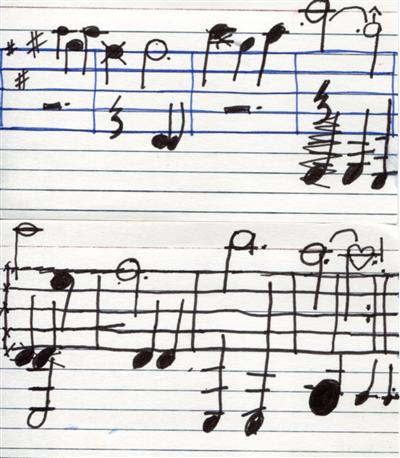Friday: Despite a long day, M and I had another nice lesson. We worked on the C and D sections of Meadow Minuet.
M had her last day of YMCA camp today. A while after I picked her up, she reported, “I cried today. We were in the woods and I got lost and started crying.” Yikes! I’d cry too if I were six years old and lost in the woods. She must not have been lost long, though, because the staff didn’t mention it to me.
After picking M up, I took her to martial-arts class. We then went out for dinner and ice cream. I knew that all this activity would leave little time for a lesson, so I told M that we would need to do some practice-related activity while we waited at the restaurant for her mother. She was agreeable, and though she did a lot of staring around the room, she actually cooperated pretty well in writing out the C and D sections of Meadow Minuet on these two index cards:
 I helped some, but she figured out and wrote most of the notes herself. (She added a repeat sign at the end “to make it pretty.” Then she drew an exclamation point above the repeat sign to show that it was just for decoration, because the song does not have any repeats.)
I helped some, but she figured out and wrote most of the notes herself. (She added a repeat sign at the end “to make it pretty.” Then she drew an exclamation point above the repeat sign to show that it was just for decoration, because the song does not have any repeats.)
This was a nice start to our lesson, because it reinforced the fact that the entire section—not just the first half—has bass notes in it. She has developed an odd habit of playing the first four bars with bass notes and the last five without, and I wanted to work on fixing this today.
We got home at about 7:30, which didn’t leave a lot of time for practice, particularly since she (quite reasonably) wanted to change into cooler clothes. But we also arrived home to find that M’s djembe was on the porch, so I was able to dangle this out as a reward: If she cooperated and we finished on time, I’d let her open the box and try out the djembe.
We practiced for about a half an hour, focusing first on the D section of Meadow Minuet and then on the C and D sections together. I asked M a lot of questions after each repetition about how she thought she did; often she just guessed, but she also sometimes answered accurately, showing that she was listening to herself. The primary technical point we worked on was holding down the melody notes long enough. She’s in the habit of leaving a note early whenever the next note involves a shift. She was resistant to me at first when I tried to correct the behavior by holding down her left-hand finger when she tried to pull it off too early, but after I demonstrated the difference between picking up early and holding down long enough, she seemed to try to hold the notes down and play more legato. Here’s an audio file of today’s last two repetitions of the Meadow Minuet C and D sections, with discussion afterwards.
She finished by playing Lightly Row twice. The first time, she sort of phoned it in (didn’t play with all the dynamics and rushed the tempo from the middle to the end, seemingly to get it over with). But the second time, she played with much more attention.
My greatest triumph today, however, was realizing that I’ve successfully redefined what a “short” lesson is. When I told her that we were done after close to 30 minutes, she responded with delight and surprise: “We’re done? With our whole entire lesson? Tee-hee-hee!”